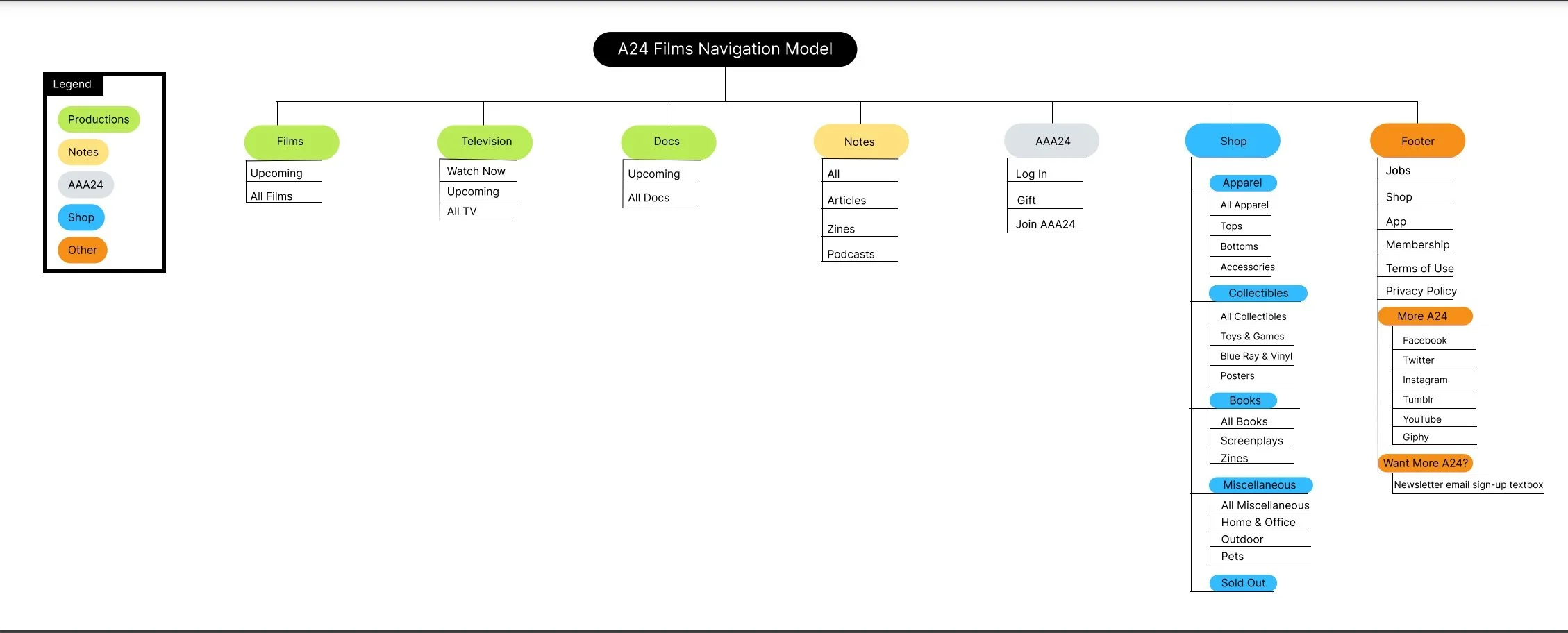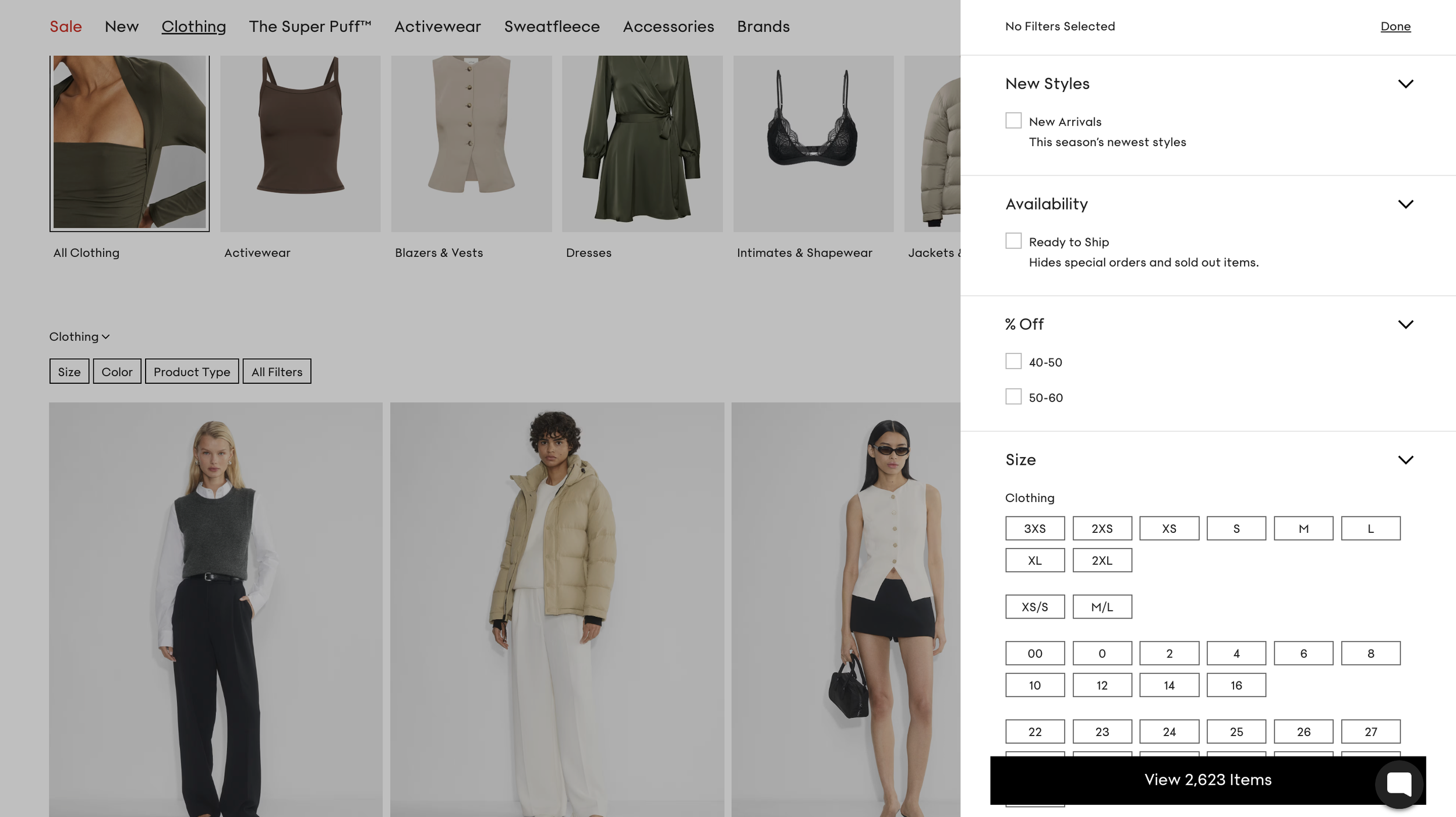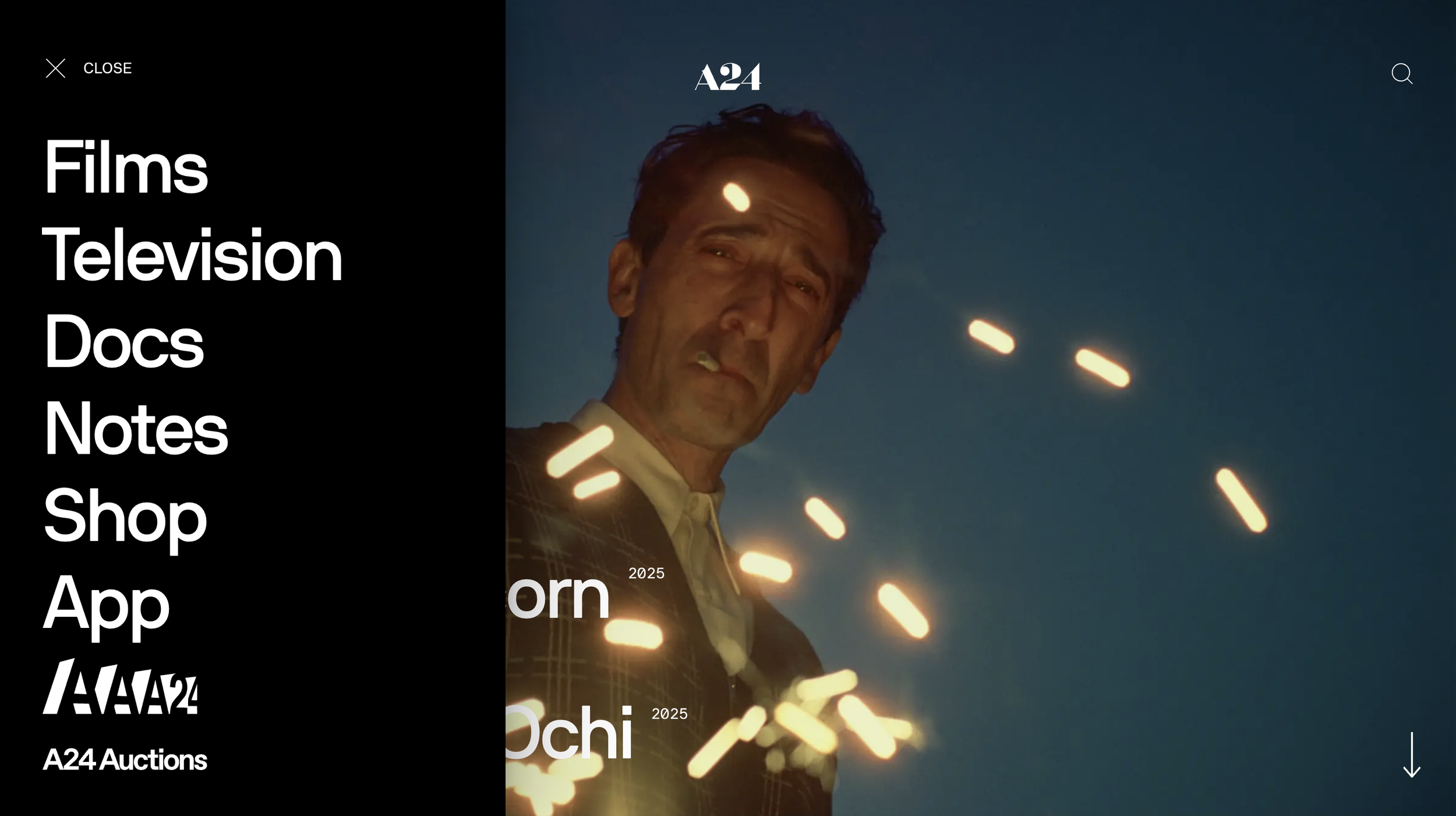A24 Information Architecture
Team Members
Ben Bunyatipanon
Chaowei Xiao
Hongyiming Cui
Jennifer Oh
Vianne Bui Nguyen
My Roles:
Product Manager
Taxonomist
Tools:
Figma
Microsoft Excel
Miro
Asana
Duration:
September 2023 - December 2023
01 Introduction
Executive Summary
A24’s website faces significant challenges: lack of connections between different elements, the absence of adequate metadata, and poor navigation. The solution to these issues is connecting information on the site, implementing metadata filtering, and reorganizing navigation labels, greatly enhancing the website's functionality and usability. Addressing these concerns will significantly improve the overall site experience, allowing users to navigate seamlessly and access content with ease.
Current State
The current state of A24’s website prioritizes artistry over accessibility and usability. Notably, there is an absence of contextual navigation, hindering seamless transitions between productions, notes, and the shop. This makes it difficult for users to discover new content they most likely would be interested in, leading to lowered engagement and merchandise sales. The lack of a filtering mechanism for productions and shop items further complicates user experience making it difficult for users to filter for the products they are interested in. Finally, the shop's confusing navigation labels contribute to poor findability, preventing users from efficiently locating desired content. Enhancing these aspects is crucial for optimizing user engagement and facilitating a more intuitive browsing experience on A24's platform.
02 Content Model Audit
Content Model
The main objects of the system include production, articles, zines, podcasts, merchandise, and membership. Here is a breakdown of the information of these objects as well as the relationships between them:
Production: A24 promotes its unique films, television series, and documentaries to stand out as an independent cinema production. Relationship wise: A production can have 0-many merchandise items, 0-many articles, 0-many zines, and 0-many podcasts.
Articles: A24 features articles related to their films, filmmakers, and the film industry in general. These articles provide deeper insights into their creative processes, background stories, as well as themes of their movies. The content of the articles give a deeper insight to engage and educate the viewers to understand their films. Relationship wise: An article relates to 1 production.
Zines: Zines offer a more tactile, intimate experience of their films, for their fans to collect an artistic piece of memorabilia. Relationship wise: A zine relates to 1 production.
Podcast: Podcasts involve conversations with filmmakers, actors, and other creatives to allow for more of a personal and intimate connection with their audience. Relationship wise: A podcast relates to 1 production.
Merchandise: A partial part of A24’s revenue comes from the merchandise that is available for purchase on the site. This includes clothing, posters, as well as various items inspired by their films. Relationship wise: A merchandise item can be about 0-1 production; there is discounted and exclusive merchandise available to members.
Membership: Another part of A24’s revenue comes from the AAA24 membership. This includes exclusive access and benefits to A24 enthusiasts and is not limited to early access to film releases, special screenings, or limited edition merchandise. Relationship wise: Members get exclusive and discounted merchandise.
Content Model Discussion
Overall, A24 is known for its visually striking films, and the same aesthetic is reflected in its website’s design. Yes, the objects may be found in the menu bar, however the overwhelming aesthetic masks the information needed in order to fully understand the entire website. The A24 website’s objects are shapeshifting, with the pattern of a simple rectangular picture, and a very small label of “podcast”, “article”, etc. leaving the user needing to dive very deep in order to access a certain service of the website.
Contextual navigation is used in two places. First, there is contextual navigation from a production to merchandise products. A production page will display related products, if applicable. However, this does not work the other way around (i.e., a shop product does not display the related production). Second, there is contextual navigation from all merchandise products to the AAA24 membership. The remaining objects—articles, zines, and podcasts—are mostly isolated. While the subject of each of these objects is a production, production titles are usually typed out and not linked (with the exception of very few), meaning there is no navigation to related productions.
Users can take action on nearly all objects. For released productions, users can follow links to view the content on different streaming services (e.g., Apple TV, Amazon, YouTube). For upcoming films that will be shown in theaters, users can follow a link to buy tickets. Podcast pages contain embedded soundtracks but users can click on the soundtrack to listen to the podcast on Spotify. Users can put merchandise products in their carts and purchase them. Lastly, users can join the AAA24 membership.
All objects communicate just the necessary amount of information about themselves—not too little but not too much. All information is relevant.
One content issue is an overlap between objects. Zines exist in two formats—digital, free zines that can be accessed in the Notes section and physical, paid zines that are merchandise in the Shop section. This might cause some confusion, especially for new users.
03 Navigation Model Audit
Navigation Model
● Films
○ Upcoming ○ All Films
● Television
○ Watch Now ○ Upcoming ○ All TV
● Docs
○ Upcoming ○ All Docs
● Notes
○ All ○ Articles ○ Zines ○ Podcasts
● Shop
○ Shop -> ■ Home ■ All ■ Archive ■ Vintage ■ Membership
○ Apparel -> ■ All Apparel ■ Tops ■ Accessories ■ Bottoms
○ Goods -> ■ All Goods ■ Home & Office ■ Outdoor ■ Pets
○ Collectibles -> ■ All Collectibles ■ Toys & Games ■ Blu-rays ■ Posters ■ Vinyl
○ Books -> ■ All Books ■ Screenplays ■ Zines
● AAA24
○ Log In ○ Gift ○ Join AAA24
Navigation Model Discussion
Users are able to access film, television, docs, notes, and shop easily from the menu tab on the home page. The categories and subcategories are designed in a way that users can easily navigate through films, television, documentaries, merchandise, and other offerings. This model caters to those wanting to explore or purchase content or merchandise. By ordering content by year, such as an 'Upcoming' section, under Films, Television, and Docs, it caters to users interested in knowing what's next from A24, keeping them engaged and coming back for more.
The structure supports business goals of selling merchandise, promoting current and upcoming productions, and engaging with the audience through various mediums like zines and podcasts. The 'Membership' and 'Join AAA24' options could be a strategy to create a community of loyal customers.
The labels are mostly clear and self-explanatory, which is good for user understanding and navigation, however, some tabs under shop, such as Archive and Vintage are not that clear and overlap with each other. The categorization under Shop includes a variety of merchandise, which is inclusive of different types of offerings by A24.
A major navigation issue is weak relationships between content and filters are limited. Films and Notes can be contextually connected, and Films can have recommendations of merchandise under Shop. For Films, Television, and Docs, there should be some filter features other than using year, but using Genre or being able to search by keywords. For Shop, there should be filter conditions such as best sellers, price range, and alphabetical order. Aside from the connectivity and filter issues, there are redundancy issues. For example, ‘Shop’ is a navigation category on the Shop page, which may confuse users. It might be beneficial to consolidate this.
03 Metadata Audit
Metadata
Metadata Discussion
We haven’t found any places where the same concept is described by two different taxonomies or sets of metadata. A fundamental reason for this is that metadata just isn’t a prominent factor in the browsing experience of the A24 website. In the most important sections where all A24 productions are shown, you can only sort their offerings by “newest” (i.e. by time) or by alphabetical order. We think a big missing part of the metadata is Genre. By including Genre in our metadata set and allowing users to sort by, an important means is provided to new users who don’t know much about A24 but would like to find content based on the genres they like.
When a user visits the details page of a production, more metadata is shown. They can now see the editor and director, release date, as well as actors and actresses of the production. Although not showing up on the parent page (where the entire list of productions is shown), these metadata could be, in fact, searched on the parent page. This probably implies that A24 has been keeping track of a set of metadata inherently, but not implementing it explicitly on the user interface. Putting that onto the table is an inexpensive operation, but can greatly improve user experience.
There are also appearances of metadata on the shop page. They are usually properties of the shop items, such as the colors or sizes of clothes. You are able to see the available colors for each item from the main page of the shop, but not sizes. We suggest A24 to make a filter function where widely used metadata taxonomies could be filtered or sorted. Just like on the production page, users technically could search for a metadata term mentioned above, but the result isn’t going to help much.
04 Solution
Competitive Analysis
Competitive Analysis Content similar to A24’s notes and shop cannot be found on competing production companies’ websites. Therefore, we chose to analyze companies in different industries that contain similar types of content and do a good job of organizing it.
Successful contextual navigation is seen on Aritzia’s website in multiple ways. Users can navigate from the blog-style stories to products by clicking on photos to access links to the clothes the models are wearing. Users can also navigate from one product to other relevant products. Each product page contains suggestions for similar products, products that complement the outfit, products in the same color, and more.
Both Aritzia and National Geographic’s shop have effective filtering systems as they each have a filtering menu that allows users to narrow down products based on appropriate metadata. National Geographic does an especially good job as it uses fitting affordances for each type of metadata, such as price using a slider.
Contextual Navigation
Productions to notes: Each production page will incorporate a ‘Related Production’ section. This will include articles, zines, and podcasts that complement the production, providing users with a more comprehensive understanding and engagement with the production content.
Notes to productions: Production names mentioned in articles and zines are hyperlinked in the content and showcased in a ‘Related production’ section, allowing users to easily navigate to associated productions.
Merchandise to productions: Each merchandise page will incorporate a ‘Related Production’ section. This will allow users to explore the productions associated with available merchandise.
Improved Shop Navigation
To optimize the shop’s navigational structure, we suggest a reorganized menu. The ‘Shop’ section should be removed, and ‘Archive’ can be labeled as ‘Sold Out’ and have a dedicated section, indicating that these items are no longer available for purchase. ‘Goods’ can be been renamed ‘Lifestyle’ for more clarity.
Cost of Inaction
The cost of inaction poses a risk of reducing the potential to gain new, long-term consumers, leading to a decline in revenue from merchandise sales due to low discoverability and findability. The absence of contextual navigation contributes to low discoverability of A24 content, while the lack of filters exacerbates the issue by resulting in low findability of merchandise. Addressing these challenges becomes crucial to avoid missing out on opportunities to attract and retain consumers, enhance discoverability, and improve the overall accessibility of both content and merchandise.











